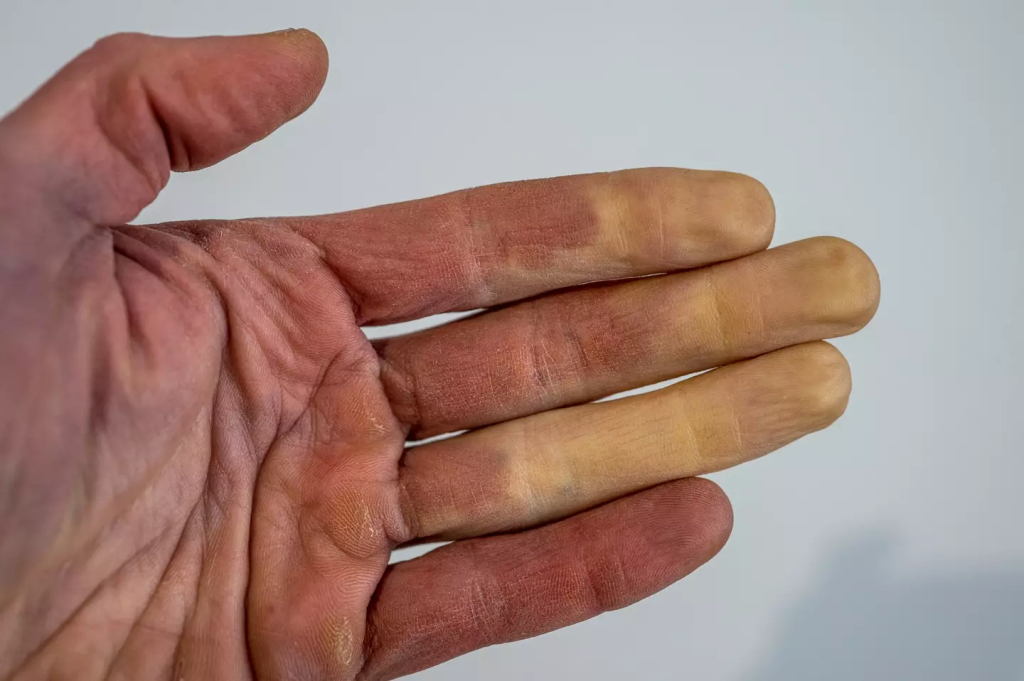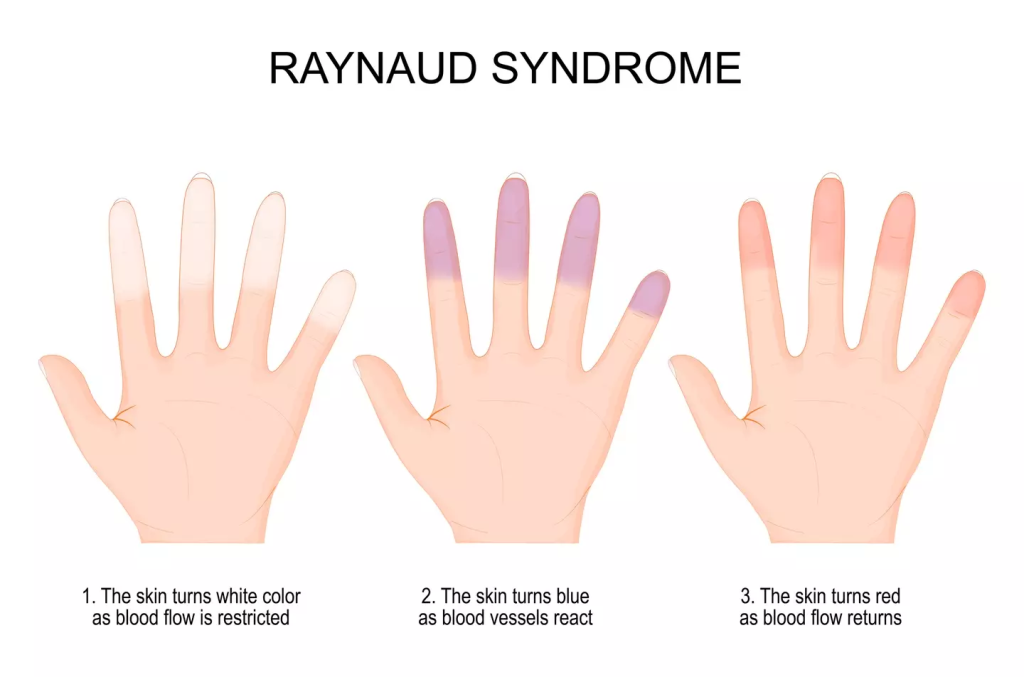Have you ever stepped out on a chilly day and noticed your fingers or toes turning pale white, blue, or even red? While it may seem like a quirky reaction to the cold, this phenomenon could be a sign of Raynaud’s disease—a common but often overlooked condition affecting millions worldwide. If this sounds familiar, let’s dive into what Raynaud’s disease is, its symptoms, and how to manage it effectively.
What Is Raynaud’s Disease?

Raynaud’s disease, or Raynaud’s phenomenon, is a condition that affects blood circulation, particularly in the extremities like fingers and toes. It happens when small blood vessels overreact to cold temperatures or stress, causing them to narrow excessively. This reaction, known as vasospasm, temporarily restricts blood flow, leading to noticeable changes in skin color.
Unlike the usual cold hands many people experience, Raynaud’s episodes can be intense. According to Dr. Melisa Lai Becker, an emergency medicine physician, “For someone with Raynaud’s, even moderate cold can cause their fingers to turn white and feel like ice.” This exaggerated response makes everyday winter activities much more challenging for those affected.
What Happens During a Raynaud’s Episode?
Raynaud’s episodes are characterized by a series of color changes in the skin due to disrupted blood flow. These changes often follow three distinct phases:
- Pale or White (Ischemia): Blood flow to the affected area slows or stops, turning the skin pale or white.
- Blue (Cyanosis): The lack of oxygen causes the area to take on a bluish tint.
- Red (Reperfusion): As blood flow returns, the skin flushes bright red, often accompanied by a tingling or warm sensation.
These episodes can last from a few minutes to several hours, depending on the severity. While fingers and toes are the most common areas affected, Raynaud’s can also impact the nose, ears, lips, and even nipples.
What Causes Raynaud’s Disease?
Raynaud’s disease can be classified into two types: primary and secondary.
- Primary Raynaud’s: This is the most common form and typically occurs on its own without any underlying medical condition. Factors like gender, age, and family history may increase the risk, with women and younger individuals being more susceptible.
- Secondary Raynaud’s: This form is less common but often more severe. It’s usually linked to other health conditions, such as autoimmune diseases like lupus, rheumatoid arthritis, or scleroderma. Certain medications, smoking, and prolonged exposure to workplace vibrations (e.g., using power tools) can also trigger secondary Raynaud’s.
Although primary Raynaud’s isn’t fully understood, researchers believe genetic and environmental factors play a significant role in its development.
Recognizing the Symptoms of Raynaud’s Disease
The hallmark of Raynaud’s disease is the striking color changes in the skin during an episode, but there are other symptoms to watch for:
- Numbness: Reduced blood flow can cause temporary loss of sensation in the affected areas.
- Pins and Needles: As blood returns, a tingling or prickling sensation is common.
- Pain: Some people experience throbbing pain in their fingers or toes after an episode.
- Cold Sensitivity: Affected areas often feel icy to the touch, even in mild conditions.
For some, symptoms are mild and occasional. For others, they can be severe and frequent, interfering with daily life. If you notice episodes becoming more intense or prolonged, it’s essential to consult a doctor.
How Is Raynaud’s Disease Diagnosed?

If you suspect you have Raynaud’s, consulting a healthcare provider is crucial. They’ll likely ask about your symptoms, triggers, and medical history. In some cases, they may perform a test called nailfold capillaroscopy to examine blood vessels in your fingers and determine whether your Raynaud’s is primary or secondary.
Dr. Lai Becker emphasizes the importance of seeking medical advice if Raynaud’s disrupts your daily life. “If the pain or numbness makes it hard to complete everyday tasks, it’s time to talk to a doctor,” she advises.
How to Manage Raynaud’s Disease

While there’s no cure for Raynaud’s disease, several strategies can help manage symptoms and prevent episodes. These include:
- Stay Warm: Wear gloves, thick socks, and layers in cold weather. Heated gloves and hand warmers can be especially effective.
- Minimize Stress: Since stress is a common trigger, practicing relaxation techniques like meditation or deep breathing can reduce episodes.
- Avoid Smoking: Smoking narrows blood vessels and can worsen symptoms.
- Exercise Regularly: Physical activity improves overall circulation and helps maintain vascular health.
- Limit Caffeine and Alcohol: Both substances can affect blood flow and exacerbate symptoms.
For severe cases, doctors may prescribe medications such as calcium channel blockers, which relax blood vessels and improve circulation.
When to Seek Medical Attention
Most cases of Raynaud’s are manageable with lifestyle changes, but it’s important to seek professional help if:
- Episodes become more frequent or severe.
- You notice sores or ulcers on your fingers or toes.
- Symptoms extend to other parts of the body, like the face or chest.
A doctor can help identify whether you have primary or secondary Raynaud’s and recommend a treatment plan tailored to your needs.
Who Is Most at Risk?

Raynaud’s is surprisingly common, affecting up to 20% of adults worldwide. Women, particularly those in their teens and early 20s, are disproportionately affected. The condition is also more prevalent in colder climates, where exposure to extreme temperatures is frequent.
Why Awareness Matters
Many people with Raynaud’s disease remain undiagnosed or unaware of their condition. Understanding the symptoms and triggers can help individuals take proactive steps to manage it effectively. If you’ve noticed unusual reactions to cold or stress, don’t ignore the signs—it might be more than just a quirky response to chilly weather.
Conclusion: Taking Control of Raynaud’s Disease
Raynaud’s disease doesn’t have to control your life. With the right strategies and support, you can minimize its impact and stay comfortable, even during the coldest months. Whether it’s bundling up in warm layers, avoiding stress, or seeking medical advice for persistent symptoms, taking action is key to managing this condition.
So, the next time your fingers turn an unexpected shade, don’t brush it off as just the cold. By understanding Raynaud’s and staying proactive, you can keep your hands warm, your circulation flowing, and your life running smoothly.


